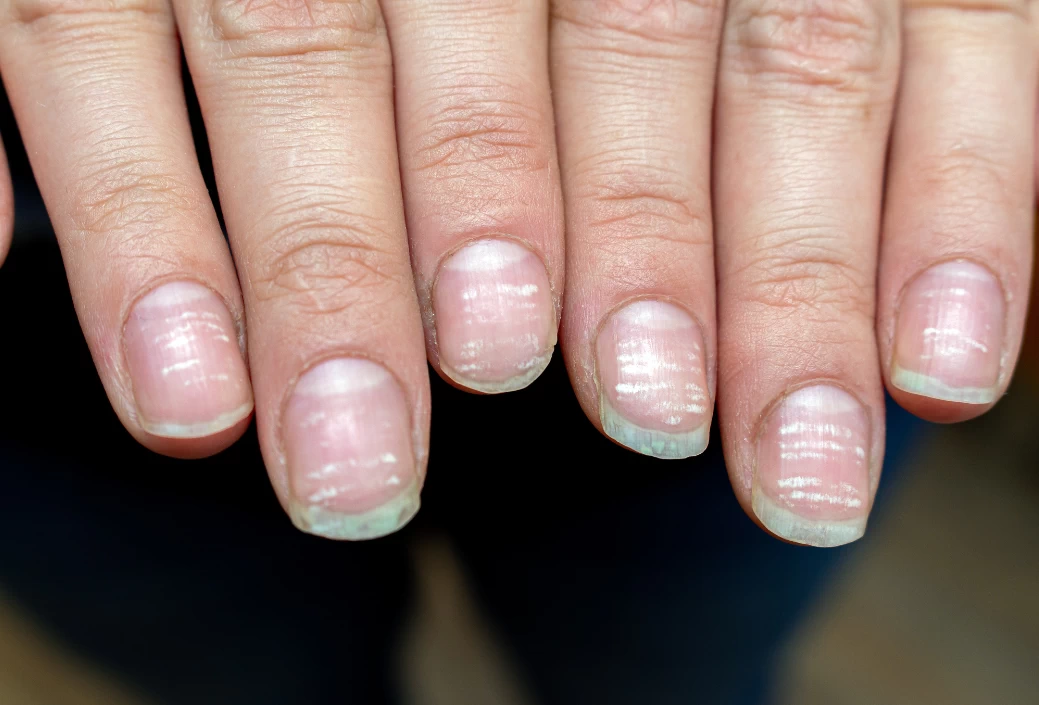
หน้าหลัก | สุขภาพดี | สุภาพสตรี | การแปลผลเลือด | โรคต่างๆ | วัคซีน | อาหารเพื่อสุขภาพ
ธาตุเหล็ก
ธาตุเหล็ก คืออะไร?
ธาตุเหล็กเป็นส่วนประกอบที่สำคัญของร่างกาย ผู้ใหญ่มีธาตุเหล็กประมาณ 3 - 4 กรัม ธาตุเหล็กอยู่ในฮีโมโกลบิน(Hemoglobin) ของเม็ดเลือดแดงประมาณร้อยละ 75 อยู่ในไมโอโกลบิน (Myoglobin)อยู่ในกล้ามเนื้อประมาณร้อยละ 5 ส่วนที่เหลือเป็นส่วนประกอบของเอนไซม์ (Enzyme) หลายชนิดในเซลล์ต่างๆ และอยู่ในรูปของส่วนประกอบของธาตุเหล็กกับโปรตีนสะสมอยู่ใน ตับ ม้าม และโพรงกระดูก/ไขกระดูก ทั่วไป ผู้ชายมีธาตุเหล็กประมาณ 0.5 - 1.5 กรัม และผู้หญิงมีประมาณ 0.3 - 1.9 กรัม แต่ในช่วงที่มีประจำเดือน ธาตุเหล็กที่สะสมในผู้หญิงจะเหลือ 0.2–0.4 กรัม
ธาตุเหล็นเป็นธาตุที่มีความสำคัญต่อสุขภาพ
ธาตุเหล็กเป็นส่วนประกอบที่สำคัญในการสร้างเม็ดเลือดแดงซึ่งจะนำเอาออกซิเจนจากปอดไปเลี้ยงยังส่วนต่างๆของร่างกาย เป็นส่วนประกอบของกล้ามเนื้อ และยังช่วยในการนำไฟฟ้าในเส้นประสาท เป็นส่วนประกอบของเอนไซม์ (Enzyme)หลายชนิดในร่างกาย โดยเฉพาะเอนไซม์ที่ใช้ในกระบวนการเผาผลาญสารอาหารให้เกิดพลังงาน หากร่างกายได้ธาตุเหล็กไม่พอก็จะเกิดภาวะโลหิตจางจากขาดธาตุเหล็ก คนส่วนใหญ่ได้รับเหล็กอย่างเพียงพอจากอาหาร แต่มีกลุ่มคนที่อาจจะจำเป็นต้องได้รับวิตามินเสริมกลุ่มที่เสี่ยงต่อการขาดธาตุเหล็กได้แก่

ผู้ที่มีโรคโลหิตจางจากขาดธาตุเหล็ก
เมื่อคนได้รับธาตุเหล็กน้อยอาจจะเกิดภาวะโลหิตจางจากขาดธาตุ้หล็กโดยจะมีค่า Hemoglobin น้อยกว่า13 g/dL ในชาย และน้อยกว่า 12 g/dL ในผู้หยิง ผู้ที่ขาดธาตุเหล็กไม่ว่าจะเกิดจากการเสียเลือดเป็นประจำ หรือผู้ที่รับประทานอาหารไม่พอ ร่างกายจะมีการสะสมธาตุเหล็กไม่เพียงพอที่จะสร้างเม็ดเลือดแดงซึ่งจะทำให้เกิดภาวะโลหิตจางจากขาดธาตุเหล็ก ซึ่งจะมีอาการที่สำคัญคือ
สาเหตุของโลหิตจางจากขาดธาตุเหล็กคือ
การตั้งครรภ์
ผุ้หญิงปกติจะต้องการธาตุเหล็กวันละ 15-18 mg เมื่อตั้งครรภ์จะต้องการธาตุเหล็กเพิ่มขึ้นถึงวันละ 27 mg เพื่อนำไปสร้างเม็ดเลือดแดงสำหรับทารก
คนที่เลี้ยงบุตรด้วยนมแม่
ทารกได้รับธาตุเหล็กจากแม่ระหว่างการตั้งครรภ์ซึ่งพอจะใช้จนถึงอายึ 6 เดือน หลังจากนั้นจะต้องได้รับนมซึ่งเติมธาตุเหล็กเสริมเนื่องจากนมแม่จะมีธาตุเหล็กไม่เพียงพอ
ผู้ที่มีประจำเดือน
จากการสำรวจพบว่าหญิงวัย12-49 ปีประมาณร้อยละ9จะมีโลหิตจางจากขาดธาตุเหล็ก เนื่องจากมีประจำเดือน และเด็กในช่วงที่เจริญเติบโตอย่างรวดเร็วจะต้องการธาตุเหล็กเป็นจำนวนมาก
การออกกำลังกาย
ผู้ที่ออกกำลังกายมากจะต้องการธาตุเหล็กเพิ่มขึ้นถึงร้อยละ30
ผุ้ที่เสียเลือดเป็นประจำ
ผู้ที่บริจาคเลือดเป็นประจำ หรือผุ้ที่เสียเลือดอย่างต่อเนื่องเช่นการรับประทานยาแอสไพริน หรือแผลในกระเพาะจะเสี่ยงต่อการเกิดโลหิตจางจากขาดธาตุเหล็ก
ผูที่เป็นโรคไตและฟอกเลือด
ผู้ที่ฟอกเลือดจะต้องได้รับธาตุเหล็กเสริมเนื่องจากมีการสูญเสียธาตุเหล็กระหว่างฟอกเลือด
ผู้ที่รับประทานยาบางชนิด
ยาที่รับประทานบางชนิดจะลดการดูดซึมธาตุเหล็ก เช่น ยารักษาโรคกระเพาะ ยาปฏิชีวนะ เช่น quinolones และ tetracyclines และมียาอื่นๆที่อาจจะทำให้ขาดธาตุเหล้กเช่น
เด็กที่มีสมาธิสั้น
จากการศึกษาพบว่าเด็กกลุ่มนี้จะมีธาตุเหล็กในร่างกายน้อยกว่าเด็กปกติ และเมื่อได้รับธาตุเหล็กเด็กมีอาการดีขึ้น
ผู้ที่มีอาการไอจากยาลดความดันกลุ่ม ACE inhibitors
พบว่าการให้ธาตุเหล็กจะลดการไอเนื่องจากผลข้างเคียงของยากลุ่มนี้
เราได้ธาตุเหล็กจากอาหารประเภทไหน
บาตุเหล็กในอาหารมีอยู่สองรูปแบบคือ
ปริมาณเหล็กที่ควรจะได้ในแต่ละวัน
| Persons | U.S. (mg) | Canada (mg) |
| ทารกจนถึง 3 ขวบ | 6–10 | 0.3–6 |
| เด็ก4-6ขวบ | 10 | 8 |
| เด็ก7-10ขวบ | 10 | 8–10 |
| ผู้ชาย | 10 | 8–10 |
| ผู้หญิง | 10–15 | 8–13 |
| คนตั้งครรภ์ | 30 | 17–22 |
| แม่ให้นมบุตร | 15 | 8–13 |
ปริมาณธาตุเหล็กในอาหาร
ก่อนการใช้ยา
ขนาดยาที่รับประทาน
ข้อควรระวัง
อาหารบางชนิดจะลดการดูดซึมของธาตุเหล็ก หากจะรับประทานอาหารให้รับประทานก่อนทานธาตุเหล็ก 1 ชั่วโมงหรือหลังจากทานธาตุเหล็กไปแล้ว 2 ชั่วโมง อาหารดังกล่าวได้แก่
สำหรับผู้ที่ซื้อยารับประทานเองโดยที่ไม่ทราบว่ายามีธาตุเหล็กเท่าใดเมื่อรับประทานในปริมาณมาก หรือเป็นระยะเวลานานอาจจะโรคที่เกิดจากเหล็กเกินซึ่งจะมีอาการดังต่อไปนี้
ในรายที่เป็นรุนแรง อาจจะมีอาการชัก ริมฝีปากปลายนิ้วจะออกสีคล้ำ
ผิวซีด เหงื่อชื้นตามผิวหนัง
หายใจหอบ หัวใจเต้นเร็ว หากมีอาการดังกล่าวให้รีบพบแพทย์
วิติมินเสริมธาตุเหล็ก
วิตมินรวมส่วนใหญ่จะมีธาตุเหล็กผสมอยู่ หากเป็นวิตามินบำรุงเลือดสำหรับสตรีจะมีธาตุเหล็กประมาณ 18 mg หากวิตามินที่มีธาตุเหล็กผสมมาก(มากกว่า 45 mg)จะทำให้เกิดอาการคลื่นไส้อาเจียน ท้องผูก
จะต้องให้ธาตุเหล็กเสริมนานแค่ไหน
เมื่อได้รับธาตุเหล็กเสริมจนกระทั้ง hemoglobin ปกติและให้ยาต่ออีก 6 เดือน
ภาวะโลหิตจาง ภาวะเหล็กเกิน
This is a reader-friendly overview of Iron. For more details, see our health professional fact sheet on Iron.
What is iron and what does it do?
Iron is a mineral that the body needs for growth and development. Your body uses iron to make hemoglobin, a protein in red blood cells that carries oxygen from the lungs to all parts of the body, and myoglobin, a protein that provides oxygen to muscles. Your body also needs iron to make some hormones.
How much iron do I need?
The amount of iron you need each day depends on your age, your sex, and whether you consume a mostly plant-based diet. Average daily recommended amounts are listed below in milligrams (mg). Vegetarians who do not eat meat, poultry, or seafood need almost twice as much iron as listed in the table because the body doesn’t absorb nonheme iron in plant foods as well as heme iron in animal foods.
| Life Stage | Recommended Amount |
|---|---|
| Birth to 6 months | 0.27 mg |
| Infants 7–12 months | 11 mg |
| Children 1–3 years | 7 mg |
| Children 4–8 years | 10 mg |
| Children 9–13 years | 8 mg |
| Teen boys 14–18 years | 11 mg |
| Teen girls 14–18 years | 15 mg |
| Adult men 19–50 years | 8 mg |
| Adult women 19–50 years | 18 mg |
| Adults 51 years and older | 8 mg |
| Pregnant teens | 27 mg |
| Pregnant women | 27 mg |
| Breastfeeding teens | 10 mg |
| Breastfeeding women | 9 mg |
What foods provide iron?
Iron is found naturally in many foods and is added to some fortified food products. You can get recommended amounts of iron by eating a variety of foods, including the following:
Iron in food comes in two forms: heme iron and nonheme iron. Nonheme iron is found in plant foods and iron-fortified food products. Meat, seafood, and poultry have both heme and nonheme iron.
Your body absorbs iron from plant sources better when you eat it with meat, poultry, seafood, and foods that contain vitamin C, such as citrus fruits, strawberries, sweet peppers, tomatoes, and broccoli.
What kinds of iron dietary supplements are available?
Iron is available in many multivitamin-mineral supplements and in supplements that contain only iron. Iron in supplements is often in the form of ferrous sulfate, ferrous gluconate, ferric citrate, or ferric sulfate. Dietary supplements that contain iron have a statement on the label warning that they should be kept out of the reach of children. Accidental overdose of iron-containing products is a leading cause of fatal poisoning in children under 6.
Am I getting enough iron?
Most people in the United States get enough iron. However, certain groups of people are more likely than others to have trouble getting enough iron:
What happens if I don’t get enough iron?
In the short term, getting too little iron does not cause obvious symptoms. The body uses its stored iron in the muscles, liver, spleen, and bone marrow. But when levels of iron stored in the body become low, iron deficiency anemia sets in. Red blood cells become smaller and contain less hemoglobin. As a result, blood carries less oxygen from the lungs throughout the body.
Symptoms of iron deficiency anemia include GI upset, weakness, tiredness, lack of energy, and problems with concentration and memory. In addition, people with iron deficiency anemia are less able to fight off germs and infections, to work and exercise, and to control their body temperature. Infants and children with iron deficiency anemia might develop learning difficulties.
Iron deficiency is not uncommon in the United States, especially among young children, women under 50, and pregnant women. It can also occur in people who do not eat meat, poultry, or seafood; lose blood; have GI diseases that interfere with nutrient absorption; or eat poor diets.
What are some effects of iron on health?
Scientists are studying iron to understand how it affects health. Iron’s most important contribution to health is preventing iron deficiency anemia and resulting problems.
Pregnant women
During pregnancy, the amount of blood in a woman’s body increases, so she needs more iron for herself and her growing baby. Getting too little iron during pregnancy increases a woman’s risk of iron deficiency anemia and her infant’s risk of low birth weight, premature birth, and low levels of iron. Getting too little iron might also harm her infant’s brain development.
Women who are pregnant or breastfeeding should take an iron supplement as recommended by an obstetrician or other healthcare provider.
Infants and toddlers
Iron deficiency anemia in infancy can lead to delayed psychological development, social withdrawal, and less ability to pay attention. By age 6 to 9 months, full-term infants could become iron deficient unless they eat iron-enriched solid foods or drink iron-fortified formula.
Anemia of chronic disease
Some chronic diseases—such as rheumatoid arthritis, inflammatory bowel disease, and some types of cancer—can interfere with the body’s ability to use its stored iron. Taking more iron from foods or supplements usually does not reduce the resulting anemia of chronic disease because iron is diverted from the blood circulation to storage sites. The main therapy for anemia of chronic disease is treatment of the underlying disease.
Can iron be harmful?
Yes, iron can be harmful if you get too much. In healthy people, taking high doses of iron supplements (especially on an empty stomach) can cause an upset stomach, constipation, nausea, abdominal pain, vomiting, and diarrhea. Large amounts of iron might also cause more serious effects, including inflammation of the stomach lining and ulcers. High doses of iron can also decrease zinc absorption. Extremely high doses of iron (in the hundreds or thousands of mg) can cause organ failure, coma, convulsions, and death. Child-proof packaging and warning labels on iron supplements have greatly reduced the number of accidental iron poisonings in children.
Some people have an inherited condition called hemochromatosis that causes toxic levels of iron to build up in their bodies. Without medical treatment, people with hereditary hemochromatosis can develop serious problems such as liver cirrhosis, liver cancer, and heart disease. People with this disorder should avoid using iron supplements and vitamin C supplements.
The daily upper limits for iron include intakes from all sources—food, beverages, and supplements—and are listed below. A doctor might prescribe more than the upper limit of iron to people who need higher doses for a while to treat iron deficiency.
| Ages | Upper Limit |
|---|---|
| Birth to 12 months | 40 mg |
| Children 1–13 years | 40 mg |
| Teens 14–18 years | 45 mg |
| Adults 19+ years | 45 mg |
Does iron interact with medications or other dietary supplements?
Yes, iron supplements can interact or interfere with medicines and other supplements you take. Here are several examples:
Tell your doctor, pharmacist, and other healthcare providers about any dietary supplements and prescription or over-the-counter medicines you take. They can tell you if the dietary supplements might interact with your medicines or if the medicines might interfere with how your body absorbs, uses, or breaks down nutrients.
Iron and healthful eating
People should get most of their nutrients from food and beverages, according to the federal government’s Dietary Guidelines for Americans. Foods contain vitamins, minerals, dietary fiber, and other components that benefit health. In some cases, fortified foods and dietary supplements are useful when it is not possible to meet needs for one or more nutrients (e.g., during specific life stages such as pregnancy). For more information about building a healthy dietary pattern, see the Dietary Guidelines for Americans![]() and the U.S. Department of Agriculture’s MyPlate.
and the U.S. Department of Agriculture’s MyPlate.![]()
Where can I find out more about iron?
Disclaimer
